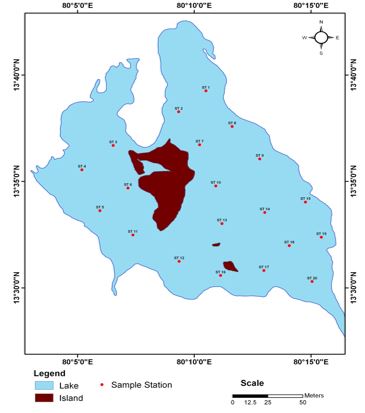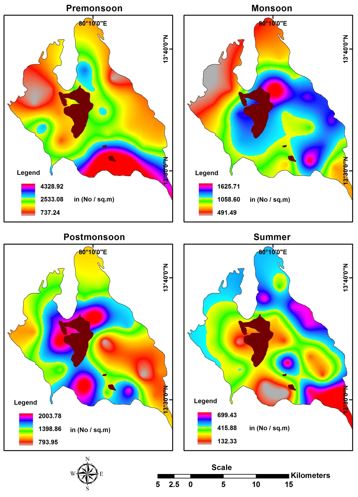GIS based benthic study @Pulicat
 In the present study, a total of 156 species were recorded for both the years. Of this 46 species of Polychaetes, 16 species of Oligochaetes, 8 species of Tanaids, 18 species of Amphipods, 14 species of Isopods, 15 species of Nematodes, 9 species of Turbellarians, 3 species of Gastropods, 5 species of copepods, 2 species of Lorcifera, 3 species of Kinorhyncha, 4 species of ostracoda, 2 species of Tardigrade , 6 species of cumacea, 4 species of Bivalves and one species of Scalopod were recorded. Cerethidium cingulata, Bullia tranqubarica, Meretrix meretrix,
In the present study, a total of 156 species were recorded for both the years. Of this 46 species of Polychaetes, 16 species of Oligochaetes, 8 species of Tanaids, 18 species of Amphipods, 14 species of Isopods, 15 species of Nematodes, 9 species of Turbellarians, 3 species of Gastropods, 5 species of copepods, 2 species of Lorcifera, 3 species of Kinorhyncha, 4 species of ostracoda, 2 species of Tardigrade , 6 species of cumacea, 4 species of Bivalves and one species of Scalopod were recorded. Cerethidium cingulata, Bullia tranqubarica, Meretrix meretrix,  Villorita cyprinoides, Heteromastus filiformis, Mediomastus capensis, Cirratulus filiformis, Apseudes spinosus and Apseudes gymnophobia were occurred in most of the stations of the Pulicat Lake in irrespective of seasons. Polychaetes and tanadiceans were dominant in terms of diversity and density (Fig. 68). All other species were less dominant. In meiofauna, nematodes were dominant than other groups in the study. Temporal variation also found in the benthic faunal groups which explained that 2010-2011 year had increased faunal density and diversity compared to the year 2009-2010. The reason might be owing to high precipitation which caused nutrient supplement to the lake. But Tanaids alone had reduction in the population in the year 2010-2011 than the previous year. It might be due to in situ production of nutrients which are lacked in 2010 -2011. The supplement of nutrient is strictly from terrigenious in 2010 -2011.The population density of benthic fauna varied from 4328.92 in St-16 to 132.33 in St-16 No/Sq.m for the year 2009-10 and for the year 2010-11, the population density varied from 1871.46 in St-2 to 132.33 in St-6 No/Sq.m. The density was high in Pre Monsoon and very low in Summer for both the years. The seasonal trend in the species density is found to be same for both the years of investigation. Comparatively benthos were enriched in 2009 -2010
Villorita cyprinoides, Heteromastus filiformis, Mediomastus capensis, Cirratulus filiformis, Apseudes spinosus and Apseudes gymnophobia were occurred in most of the stations of the Pulicat Lake in irrespective of seasons. Polychaetes and tanadiceans were dominant in terms of diversity and density (Fig. 68). All other species were less dominant. In meiofauna, nematodes were dominant than other groups in the study. Temporal variation also found in the benthic faunal groups which explained that 2010-2011 year had increased faunal density and diversity compared to the year 2009-2010. The reason might be owing to high precipitation which caused nutrient supplement to the lake. But Tanaids alone had reduction in the population in the year 2010-2011 than the previous year. It might be due to in situ production of nutrients which are lacked in 2010 -2011. The supplement of nutrient is strictly from terrigenious in 2010 -2011.The population density of benthic fauna varied from 4328.92 in St-16 to 132.33 in St-16 No/Sq.m for the year 2009-10 and for the year 2010-11, the population density varied from 1871.46 in St-2 to 132.33 in St-6 No/Sq.m. The density was high in Pre Monsoon and very low in Summer for both the years. The seasonal trend in the species density is found to be same for both the years of investigation. Comparatively benthos were enriched in 2009 -2010
